As heart rate monitors gain popularity, an increasing number of athletes are focusing on this physiological metric. But what about the highest heart rate? What is the most effective approach to compute (or gauge) your maxHR? And is it feasible to boost your ultimate heart rate through training? The response to this final query will unquestionably catch you off guard.
In this piece, I will scrutinize what we comprehend regarding maximum exertion heart rate. Additionally, I will disclose some of the information I’ve accumulated over the past several years during my physiological evaluations. Upon finishing perusing this article, you will grasp everything requisite concerning maximum heart rate and its practicality for training.
Let’s commence with the fundamentals.
Rationale behind the Augmentation of Heart Rate during Physical Exertion
The heart, a muscle that aids in circulating blood throughout our body is among its many functions. Blood laden with CO2 (carbon dioxide) returns to the heart via the veins. Subsequently, it undergoes oxygenation (and rids itself of CO2) in the pulmonary capillaries. Ultimately, the oxygen-rich blood is propelled to the muscles and organs by the left ventricle.
During physical exertion, muscles necessitate more oxygen. The body escalates heart rate to satisfy this escalating demand for O2. The escalation in heart rate during physical activity is primarily attributed to stimulation of the sympathetic branch of the autonomic nervous system.


Maximum heart rate is denoted in beats per minute (abbreviated “bpm”).
Factors Affecting Heightened Heart Rate
Multiple intrinsic and extraneous factors distinctly influence heart rate during physical activity.
In case of training in a warm setting, your heart rate will exceed the typical range. Your body utilizes blood for both oxygen transportation and internal heat dissipation. In heightened temperatures, your body diverts a portion of the blood to the skin for reducing internal temperature.
Elevation is another external factor exerting an impact on your heart rate, both while at rest and engaged in physical activities. At altitude, the oxygen content in the atmosphere is appreciably lower than at sea level. Consequently, your body raises its heart rate to furnish the requisite oxygen to the muscles and organs.
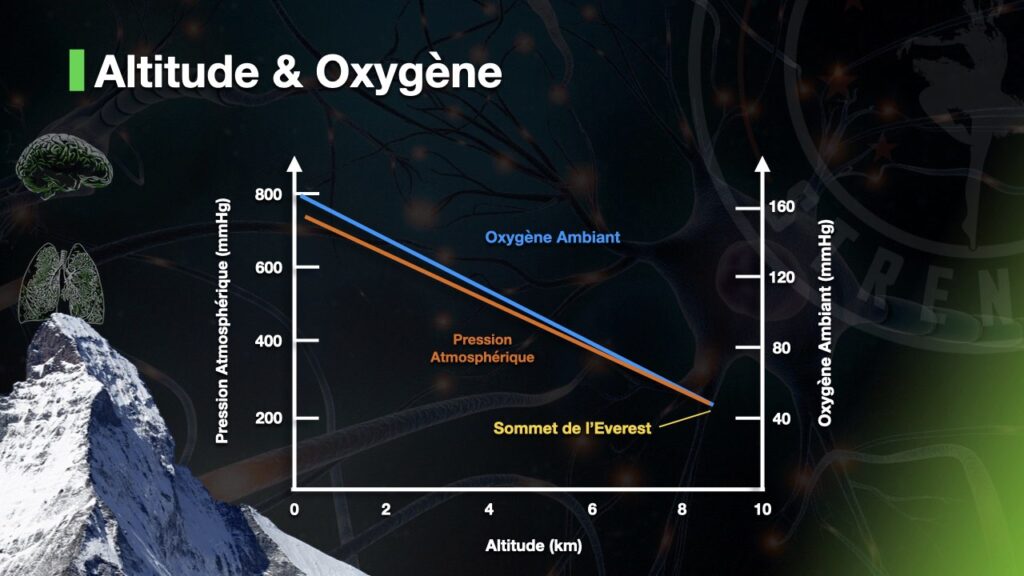

When unwell, it is common to register elevated heart rates. In such scenarios, inflammation and heightened body temperature appear to be the sources of an elevated HR.
You now comprehend the diverse mechanisms underlying heightened heart rate. Now let’s ascertain whether there exists a direct correlation between maximum heart rate and athletic performance.
Max Heart Rate & Athletic Performance
In contrast to prevalent belief, an elevated maximum heart rate is not linked to superior athletic prowess. In reality, the inverse seems to hold true.
In a 2000 study, Zavorsky expounds that as physical fitness (VO2max) elevates, HRmax appears to decrease. By as much as 7%. This can be rationalized by the fact that endurance training elevates blood plasma volume. The greater the blood volume in the body, the more the heart fills before each beat (termed “ventricular preload”), and subsequently, it can eject more blood with each beat. If the heart expels more blood with each beat, its rate diminishes (for a given total volume).
Cardiac output equation Q = HR x SV
Q = Cardiac Output || HR = Heart Rate || SV = Stroke Volume
In a recent study contrasting cycling and running data, Kasiak et al. noted that sedentary individuals exhibit a lower maximum heart rate on average compared to trained subjects.
Discrepant Max HR in Men & Women
In a study carried out in 2014 encompassing over 37,000 participants, researchers demonstrated that men manifested a higher Max HR than women (on average, a 3-beat disparity).
I also managed to discern this minor variance in the results of physiological tests. Note that the demographic represented in my data predominantly comprises of CrossFitⓇ competitors assessed on a BikeErg utilizing Protocol 41.
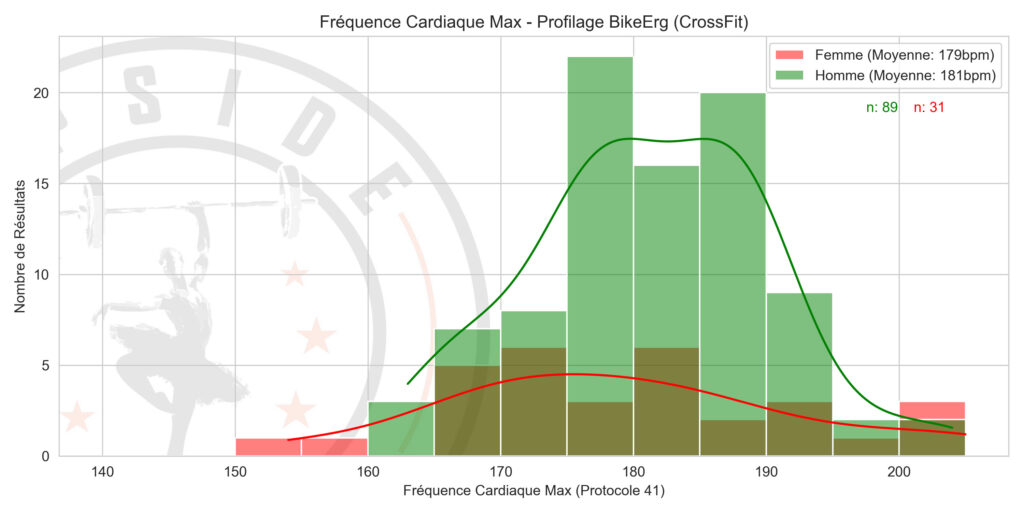

Maximum Heart Rate Relative to Age
As individuals age, their maximum heart rate typically decreases in a linear fashion. Nevertheless, there exists substantial variability in maximum heart rate among different individuals. It appears that for women, the decline in maximum heart rate occurs at a slower rate compared to men over time.
Prior to delving into various methods for measuring maximum heart rate during physical activity, let’s explore the calculations utilized to establish an estimated maximum heart rate.
Determining Your Maximum Heart Rate
The calculations used to estimate maximum (potential) heart rate offer a distinct advantage in providing a reference value for individuals unable to exert maximum effort.
The most widely recognized formula for estimating an individual’s MaxHR is expressed as:
220 – age
Based on my research into scientific literature, it seems that this equation lacks a definitive source. It may potentially stem from a study conducted in 1971, but this attribution remains uncertain.
While this equation seems to align reasonably well with the average of measured HRmax values, it possesses a significant margin of error (plus or minus 15 beats). Upon referring to the diagram above, numerous data points notably deviate from the average (represented by the black line).
For example, the theoretical maximum heart rate for a 40-year-old individual is 180bpm (220 – 40 = 180). Nonetheless, actual measured values range from 158 to 205 beats per minute. This degree of discrepancy is excessively large for practical applications.
Are there more accurate formulas for calculating maximum heart rate?
There exist numerous alternative formulas for calculating an individual’s maximum heart rate. I could elaborate on them here, but perhaps it is wiser to directly address the conclusion of Robergs et al in their 2002 review:
“Currently, there is no acceptable method to estimate HRmax.”
We will revisit the discussion of estimating max heart rate for the purpose of defining heart rate training zones later.
First, let’s examine which performance tests can directly measure the maximal heart rate an individual can achieve.
Protocols for Assessing Maximum Heart Rate
At present, there is no specific protocol for measuring maximal heart rate during physical exertion.
When seeking to measure your maximum heart rate, you should satisfy at least two criteria:
- Be in a physical condition that enables you to exert maximum effort
- Select a test of sufficient duration and/or intensity to elicit the highest possible heart rate.
Assuming good health, there are numerous tests available to measure your maximum heart rate. For instance, you can use a Maximum Aerobic Speed Test, a Cooper or 1/2 Cooper running test, or a FTP (20-minute) cycling test.
Personally, I apply Protocol 41 to assess lactate thresholds, heart rate, oxygen consumption (VO2), and muscle oximetry. This protocol enables measurement of the average heart rate at each level as well as the maximum heart rate achieved on the final completed stage.
It is worth noting that for the same individual, different modalities will yield varying measurements of max heart rate. This will be explored further in the subsequent section.
Max Heart Rate across Different Sports
Several factors contribute to variations in heart rate based on the type of physical activity.
Primarily, the body’s orientation in space plays a significant role. For illustration, consider running and swimming. When running, the body maintains a vertical position, whereas during swimming, the body adopts a completely horizontal orientation. You can verify this firsthand: lie down on your bed and measure your heart rate for 60 seconds, then stand up and measure your heart rate while standing. Note the difference?
Additionally, the muscle mass involved in each activity differs. Higher recruitment of muscle mass results in an elevated heart rate to supply these tissues with oxygen.


It’s essential to consider the type of muscle contraction involved in each physical activity. While running, each stride produces an impact that needs to be absorbed. As a result, muscle contractions have a considerable eccentric aspect. On the other hand, cycling lacks an eccentric phase, and the absence of impact significantly alters muscular and hence cardiac requirements.
Overall, it can be assumed that an individual will achieve their highest maximum heart rate while running. The maximum heart rate for cycling will be slightly lower, and for swimming, it will be even lower than that for cycling.
Nevertheless, there are exceptions. In the case of an elite cyclist, it’s highly probable that their HR max while cycling will be higher than their peak rate while running. Therefore, the individual’s training status in a specific modality should also be considered.
Let’s consider how the maximum heart rate can be utilized for zones.
Using Maximum Heart Rate to Define Training Zones
The maximum heart rate is primarily utilized to determine cardiac training zones. These zones allow us to personalize our training and target intensities that align with our objectives.
However, there’s a significant drawback to this approach.
Most individuals determine their training zones based on fixed percentages of their HRmax (calculated or measured). Just as there’s a substantial margin of error in calculating HRmax, the same applies to HRmax percentages at different zones.
The graph below demonstrates the distribution of threshold 1 as a percentage of (measured) HRmax. Threshold 1 signifies the shift between Zone 2 and Zone 3. We observe that the average falls slightly below 70% of the maximum heart rate, which is commonly used for zone calculations. However, there is also a broad variance above and below 70%.
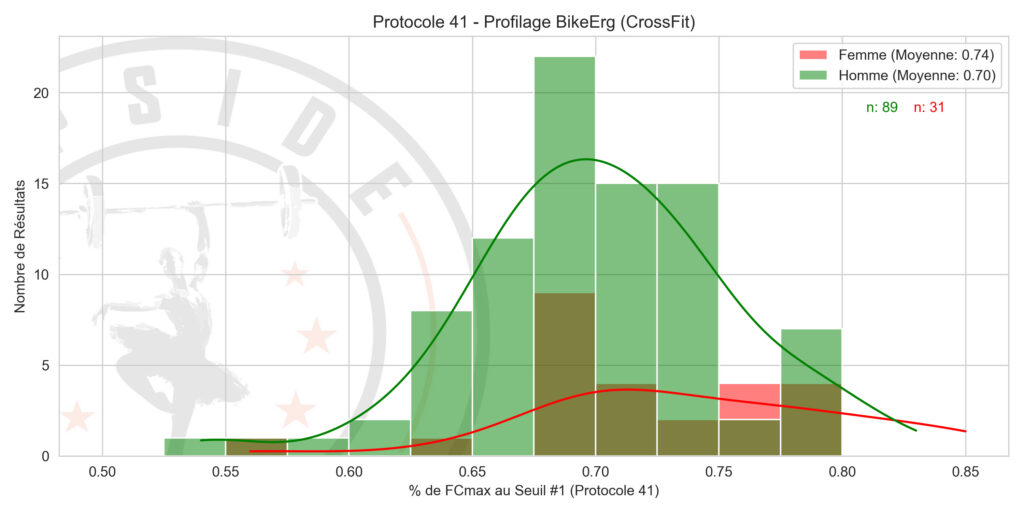

An Alternative to Percentages of Max Heart Rate
Without physiological data enabling the rigorous determination of the two thresholds, I suggest using the Rating of Perceived Exertion (RPE) to estimate the zones. This method necessitates self-awareness and unfortunately isn’t widely taught.
It’s an essential skill that will yield significant advantages in your athletic pursuits. In a world dominated by data and gadgets, the ability to quantify and manage your own effort is akin to a superpower!
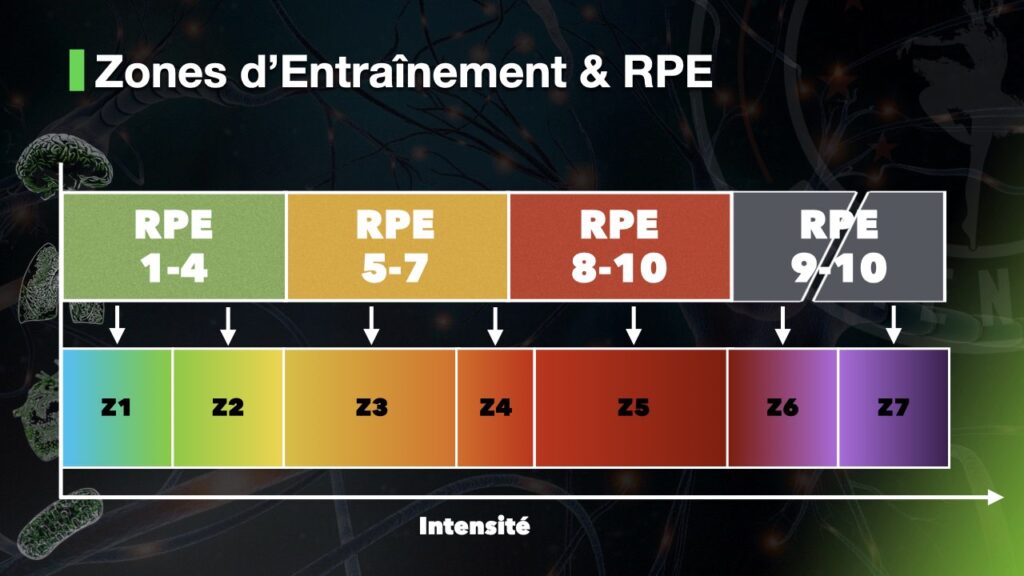

Before concluding this piece, I’d like to address a phenomenon I’ve observed on several occasions – the increase in MaxHR through training…
Can Maximum Heart Rate be Enhanced?
Theoretically, HRmax is not a value that can be directly influenced. However, in my various evaluations, I’ve encountered several instances where the peak heart rate did indeed increase as a result of targeted training.
So what’s the rationale behind this?
These changes were evident in individuals who had engaged in my Bike ENDURE training program between their two assessments. Firstly, I’ll present the data I gathered, and then I’ll share my theory regarding the augmentation of their HRmax.
All these trials were conducted on a BikeErg using Protocol 41.
Mattéo: Lactate Curve & Maximum HR
This first participant underwent two identical assessments with a 5-month gap. During this period, he followed my Bike ENDURE program for 10 weeks. On the second evaluation, he completed 2 additional stages compared to the initial test. Moreover, there was an evident alteration in his lactate curve, with his heart rate ascending to 203bpm from 194bpm in the initial test.
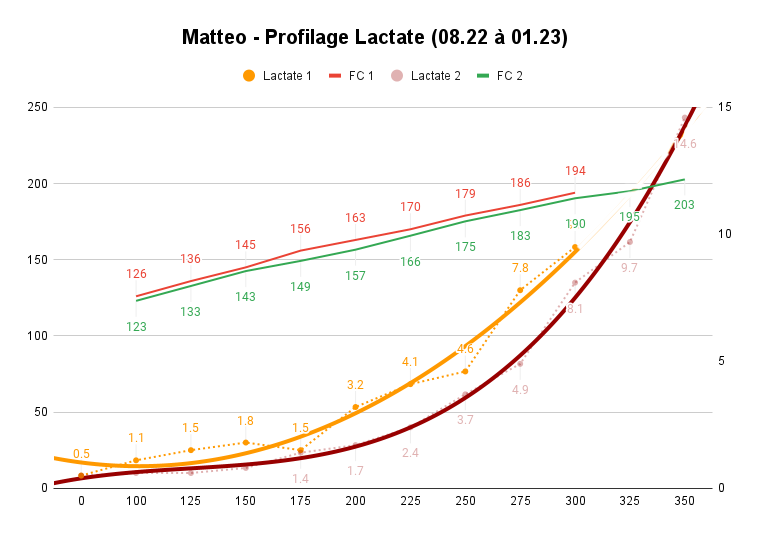

Thomas: Maximal and Submaximal Heart Rate
The discrepancy in HRmax is less apparent for this individual. However, there is a slight elevation in maximum heart rate, from 167 to 169bpm. The most significant transformation occurred in the submaximal HR at each stage. This subject also adhered to the Bike ENDURE regime.
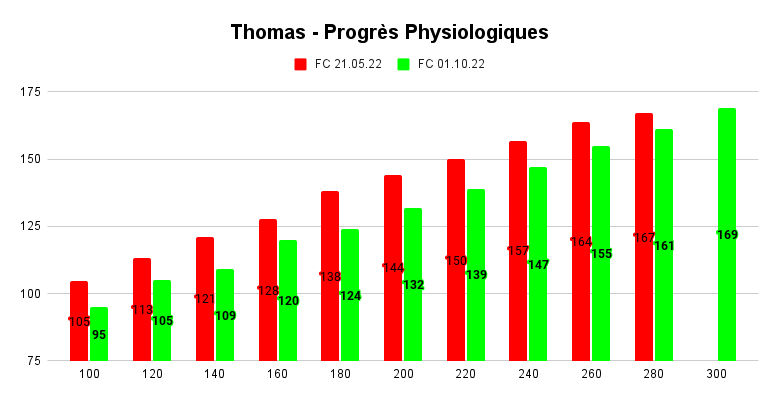

Andreas: Maximum and Sub-Maximum HR
This third participant demonstrated an 11-beat increase in maximum heart rate during the second assessment (177bpm vs. 166bpm). A substantial shift!
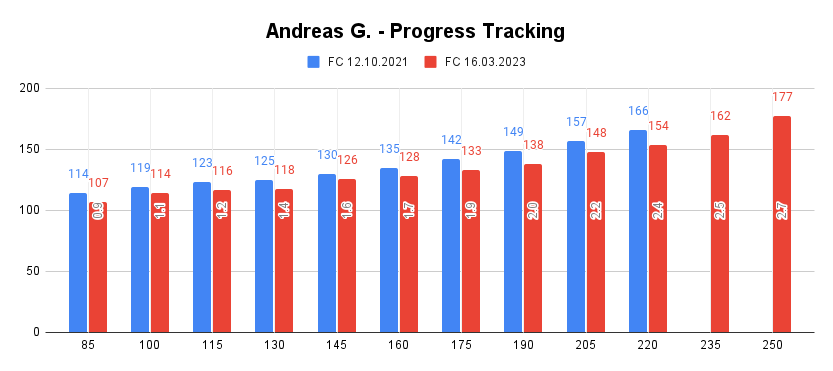

Alex: Lactate Curve & FC Max
This final participant underwent two identical assessments 12 months apart. During this period, he switched between my Bike ENDURE and Bike POWER programs to foster all his endurance attributes for CrossFitⓇ. The dissimilarity in maximum heart rate (188bpm vs. 171 in the initial test) is noticeable. There is also a noticeable progression in his lactate curve and performance. He completed 3 more stages in the second test than in the first.
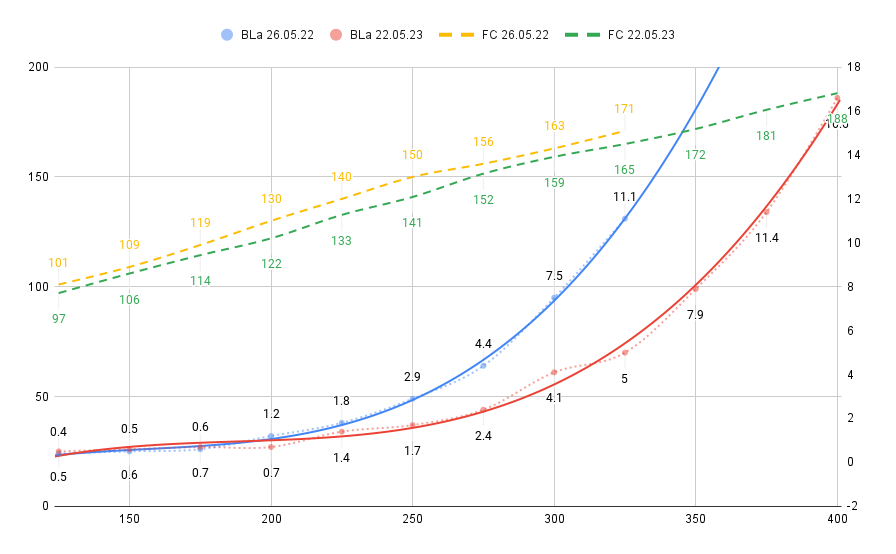

So why is Max Heart Rate increasing?
The Bike ENDURE program enhances essential endurance attributes such as mitochondrial density and the capacity to recycle lactate. My leading explanation for the escalation in HRmax is as follows:
All these participants were, in some manner, constrained by their muscular system or metabolism. What I’m implying is that their limitation didn’t appear to be related to their respiratory or cardiovascular systems. Initially, the HRmax they registered was solely determined by the maximum their legs could facilitate. Following a training program that improved their “muscular resistance” and “metabolism,” they were able to excel in the test and exertion, resulting in a higher maximum heart rate.
Key Points:
- Estimations for maximum heart rate are typically imprecise.
- Zones based on % of maxHR are frequently inaccurate (unless you’re fortunate!).
- Maximum heart rate for the same individual may fluctuate based on training approach and proficiency level.
To sum up, I believe making use of HRmax, whether measured or estimated, as a foundation for training or training parameters (zones) is not advisable. At most, this value can serve as a benchmark over time to quantify your fitness level in a structured test like Protocol 41.
If you enjoyed this article, kindly share it with someone who can benefit from it!
If you wish to boost your endurance and recovery capacity, join over 200 participants in the Bike ENDURE program by clicking here.
References:
Exploration and Potential Mechanisms of Modified Peak Heart Rate With Endurance Training and Tapering (Zavorsky et al, 2000)
Maximum heart rate diminishes steadily with age, regardless of cardiorespiratory fitness levels (Ozemek et al, 2014)
Benchmark Values for Cardiorespiratory Response and Fitness on the Treadmill in a Population Aged 20 to 85 (Edvardsen et al, 2013)
Correlation between exercise heart rate and age in males vs females (Sydo et al, 2014)
The unexpected background of the “HRmax=220-age” formula (Robergs et al, 2002)
Credibility of the Models for Predicting Maximum Heart Rate among Runners and Cyclists (Kasias et al, 2023)
Maximum Heart Rate: Common Inquiries
There’s no upper limit on maximum heart rate that you can surpass. The crucial thing is to train at intensities that align with your objectives and current capabilities.
Maximum heart rate varies significantly from individual to individual, depending on age, gender, training method, and training proficiency. The FCmax range is between 140 and 220.
Maximum heart rate is not truly a physiological boundary. As illustrated in the article, it is feasible to elevate your heart rate with appropriate training.
The appropriate heart rate to maintain during exercise will primarily depend on your training level and the goal of the session. Due to substantial variability in heart rate among individuals, there is no universally ideal rhythm.
A healthy heart is generally characterized by low resting heart rates (below 50bpm) and consistent values at high exertion levels.
Heart rate diminishes progressively with age. The widely used 220 – age calculation, even though with a substantial margin of error (+ or – 15 beats).
There is no ideal % MHR for losing weight. The most effective approach involves (mild) calorie restriction along with a well-structured training regimen that is sustained over time.
A swiftly rising heart rate during exertion generally indicates a lack of fitness. Opt for low-intensity training (Zone 2 type) to accumulate substantial training volume and enhance your exercise heart rate.
No heart rate is considered perfect. The key is to train at intensities aligned with your objectives and current capabilities.
Heart rate during a 10km race can vary significantly from one individual to another. There is no universally ideal heart rate for a 10km run.
Absolutely! A well-structured training program can reduce not only your resting heart rate, but also your heart rate during different exertion levels.
Click here to avail of the reduced price for Smoothies For Weight Loss while it’s still accessible…
[ad_2]

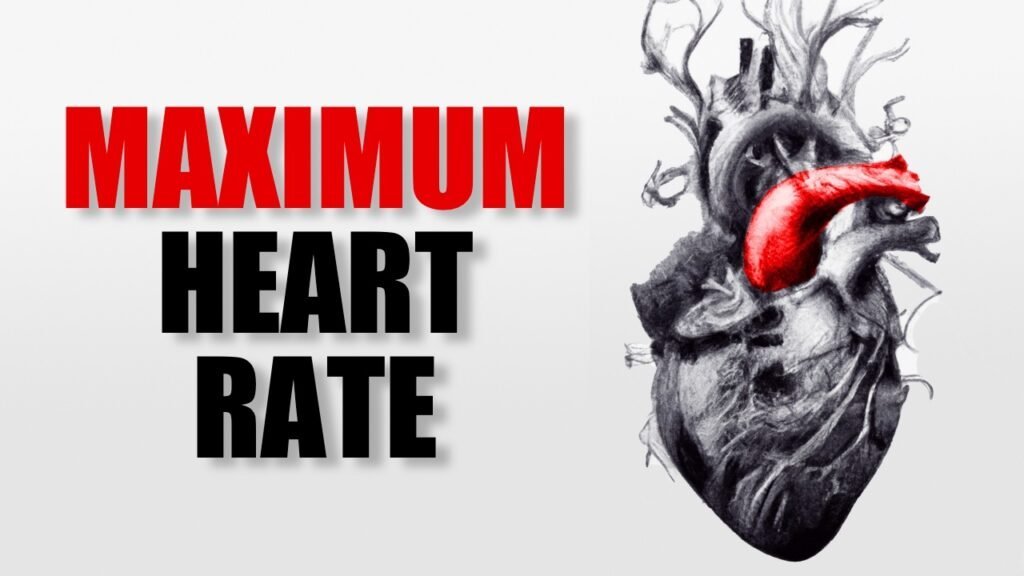

2 Comments
Urgent cleaning specialists, emergency became opportunity. Emergency cleaning perfected. Crisis champions.
Dry Cleaning in New York city by Sparkly Maid NYC